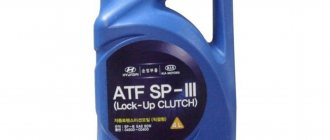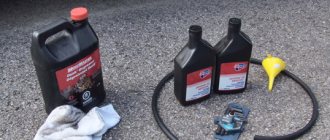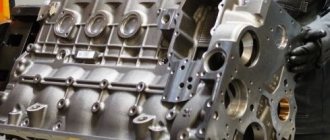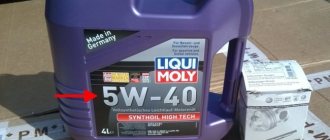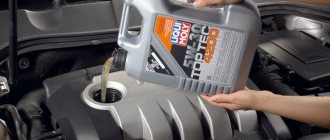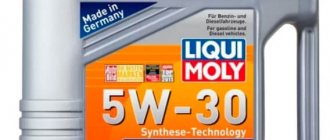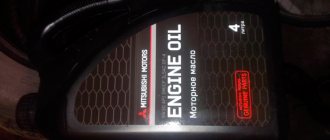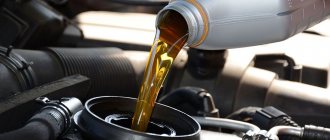Most popular MTFs
In modern cars, professionals recommend using two groups of consumables:
- Synthetics.
- Semi-synthetic.
The most popular brands remain domestic and imported lubricants:
Lukoil TM4 75W90
Semi-synthetic with a high viscosity index.
ZIC GF Top 75W90
In 2015, this synthetic oil was on the first step of the rating. It has excellent anti-friction properties.
Castrol Syntrans Transaxle 75W90
Special oil used in vehicles equipped with manual transmissions with bronze synchronizers. The properties are distinguished by excellent anti-scuff characteristics. Corresponds to class GL4.
Liqui Moly Hypoid-Getriebeoil TDL 75W90
Semi-synthetic universal oil. Can be used in any type of manual transmission. Reliably protects parts from corrosion and has excellent heat resistance.
Description of Lukoil brand oils
Lukoil products are of high quality, as they are made from high-quality base oils using the latest technologies. This also applies to transmission lubricants. According to reviews from car enthusiasts, this is one of the best manufacturers of lubricants. The company's products are in great demand.
Transmission lubricants are available in a wide range; mineral oil, semi-synthetic and synthetic are available.
The main purpose of this product:
- protect the rubbing surfaces of transmission parts from wear and damage in the form of chips and scuffs;
- help reduce noise, vibration, and energy losses due to friction during engine operation;
- reduce shock load;
- provide ease of gear shifting;
- help remove heat from contacting and rubbing parts;
- protect against corrosion and oxidation.
Lubricants are classified by viscosity (an indicator of fluidity with temperature changes) and purpose. Three groups of symbols are used in oil designations. 1st TM group means that this is gear oil. Group 2 shows performance properties. Group 3 means viscosity grade.
Varieties
Semi-synthetics TM-5 75W90 is intended for manual transmissions of hypoid gears in transfer cases and drive axles, suitable for both passenger cars and trucks. It is made on the basis of semi-synthetic highly purified petroleum products. Meets SAE 75W-90 viscosity grade and performs well at low temperatures. Thanks to additives, it has extreme pressure and anti-corrosion properties.
Extends transmission life, increasing its reliability.
LukoilTM-5 75W90
Transmission lubricant TM-5 80W90 is made on a mineral basis for use in manual transmissions of both passenger cars and trucks, as well as in units of other equipment using hypoid gears operating under high load conditions. The quality class corresponds to API GL-5. The additives included in the oil increase the protection of the transmission from corrosion and oxidation processes, extending the life of the unit. The additives used in production have extreme pressure properties and reduce wear of parts.
Semi-synthetic TM-4 75W90 is made on the basis of high-quality hydrosynthetic base oils and can be used year-round in manual transmissions in automobiles and trucks. The composition includes additives that increase anti-corrosion properties.
Semi-synthetics for transmissions Lukoil TM-4
Mineral transmission oil TM-4 80W90 can be used in all manual transmissions of cars. High-quality purified base oils were used as the basis for production. An effective additive package provides protection against corrosion and oxidation, and extends the service life of the transmission. Additives increase service life. They do not lose their properties at any operating temperatures.
Lukoil ATF lubricant is intended for automatic transmissions. Contains high-quality effective additives from global automakers, which increase resistance to destruction, make it possible to work at different temperatures, and help reduce friction between contacting parts.
Automatic transmission lubricants
Application
Lukoil products meet international quality standards. Mineral, semi-synthetic and synthetic oils are used for manual and automatic transmissions; they are also used in hypoid transmissions of drive axles and transfer cases, and in worm gears. They can be used in gearboxes of automobile transport, trucks, and in units of various special and agricultural machinery that operate in difficult conditions.
We recommend: ECU diagnostics – a job that cannot be delayed
Depending on the purpose and properties, lubricants are divided into 5 groups. They are used in transmissions of passenger cars and trucks, tractors, buses, in units of industrial equipment, in units that use worm and gear drives. Thanks to alloyed multifunctional additives produced domestically and abroad, lubricants protect transmission parts from corrosive and oxidative processes. Special additives increase the extreme pressure and anti-wear properties of fluids, thereby extending the service life of transmissions. Do not freeze at low temperatures.
Advantages and disadvantages
Lukoil transmission oils have the following advantages:
- protect parts of components from wear, extend their service life;
- reduce friction between contacting parts;
- ensure operation of the gearbox in a wide range of operating temperatures;
- allow you to work at high pressure;
- lubricants are economical, thanks to additives they can not be changed for a long time;
- have high anti-corrosion and extreme pressure properties;
- ensure stable operation of the transmission at low temperatures;
- resistant to oxidative processes;
- low cost.
According to driver reviews, Lukoil lubricants are practical to use. The disadvantage is that counterfeits are common.
Classification by API
This system allows you to identify and select engine oils based on required service conditions and performance characteristics. The API service classification system considers the structure of the mechanism, operating conditions and viscosity index as the main parameters. Protective additives are considered as an additional factor. An API document adopted in 1976 provides for the division of GL (Gear finoilcant) into several groups in accordance with the performance properties of the lubricant.
- GL-1
. Designed for light operating conditions. There are no additives or very few of them. These are mainly antioxidant, antifoaming and light depressant substances. They are used in mechanisms with worm, spiral-bevel and cylindrical gears, as well as in manual gearboxes without synchronizer. - GL-2
. Used in mechanisms operating at medium speeds and loads. Lubricants of this group have anti-wear additives and are usually used in gearboxes and worm gears of tractors and other agricultural machinery. - GL-3
. Designed for spiral bevel gears operating under moderately severe conditions. The amount of anti-wear additives can reach 2.7%. As a rule, they are used for checkpoints of freight transport. The GL-3 grease group cannot be used for hypoid gears. - GL-4
. Designed to work in various conditions: light, medium, hard. These lubricants contain up to 4% extreme pressure additives. GL-4 can be used for hypoid/stepped transmissions of all types of vehicles. These oils are the main ones for synchronized gearboxes. - GL-5
. Designed for all types of gears operating in the most difficult conditions: at high speeds and varying loads. The amount of additives in the lubricant can reach 10%. To be used in a synchronized gearbox, the gear oil must be approved by the manufacturer.
In addition to the above five groups, additional two classes of lubricants were developed, proposed in 1998. This:
- PG-1, equivalent to GL-5, but having better thermal stability;
- PG-2, intended for drive axles of buses and freight vehicles.
General characteristics
The Russian market today offers two products for transmission units from Lukoil, which have a viscosity index according to SAE 75W-90:
- TM-4 (GL-4);
- TM-5 (GL-5).
Let's first consider the general parameters of these two transmission oils.
Purpose
Lukoil 75W-90 transmission oils are designed for operation in units where the lubricant does not have the function of energy transfer. That is, these lubricants perform only lubricating and protective functions and are not suitable for use in automatic transmissions and CVTs.
SAE Viscosity
As can be seen from the index, the lubricants in question for transmission units are all-season. The winter viscosity index, 75W, allows the use of oil at ambient temperatures down to –40 °C.
What does this limitation mean in a physical sense? If for an internal combustion engine the limits for winter viscosity mean whether the pump can pump lubricant through the system and whether the crankshaft will turn, then for transmission oils these restrictions have a slightly different meaning.
The minimum temperature for transmission lubricants limits the threshold at which the formation of a reliable protective film on the surface of rubbing parts is ensured.
At lower temperatures, the lubricant thickens so much that the formation of a normal protective layer is not guaranteed. The summer part of the index, 90, indicates that the gear oil is acceptable for use at ambient temperatures up to +35 °C.
Depending on the API tolerances or GOST class, the scope of application of the lubricants in question varies. Let's take a closer look at the conditions for which Lukoil TM-4 75W-90 (GL-4) and Lukoil TM-5 75W-90 (GL-5) oils are designed.
Classification of transmission oils
In accordance with GOST 17479.2-85, there are 4 classes of transmission oils by viscosity (Table 10) and 6 viscosity classes by SAE (Table 11).
Table 10
Classes and values of kinematic viscosity of domestic gear oils
| Viscosity grade | Kinematic viscosity at a temperature of 100 ºС, cSt | The temperature at which dynamic viscosity does not exceed 150 Pa∙s, ºС, not higher |
| 9 | 6,00…10,99 | -35 |
| 12 | 11,00…13,99 | -26 |
| 18 | 14,00…24,99 | -18 |
| 34 | 25,00…41,00 | – |
Table 11
Classification of gear oils by viscosity (SAE standard)
| Viscosity grade | The temperature at which dynamic viscosity does not exceed 150 Pa·s, ºС, not higher | Minimum kinematic viscosity, cSt at a temperature of 99 ºС |
| 75W | -40 | 4,2 |
| 80W | -26 | 7,0 |
| 85W | -12 | 11,0 |
| 90 | – | 13,5 (24,0)* |
| 140 | – | 24,0 (41,0)* |
| 250 | – | 41,0 |
| *The maximum kinematic viscosity at 99 ºС is indicated in parentheses. | ||
The first three classes of oils presented in table. 11 are winter and have the index “W”. For them, the requirements for low-temperature viscosity properties are standardized. In addition, the SAE classification provides for the use of three summer classes. All-season oils according to SAE have a double designation: SAE 80W/90, 80W/140, 85W/140 (Table 12).
Table 12
Compliance of domestic viscosity classes and SAE classification
| Viscosity class according to GOST | SAE viscosity grade | Viscosity class according to GOST | SAE viscosity grade |
| 9 | 75w | 18 | 90 |
| 12 | 80w/85w | 34 | 140 |
In domestic practice (Table 13), as well as in the USA and Western European countries, various classifications of transmission oils according to the level of performance properties are accepted.
Table 13
Classification of domestic transmission oils depending on pressure and temperature in the gear mesh zone
| Group of oils by operational properties | Oil composition | Recommended application |
| TM-1 | Mineral oils without additives | Cylindrical, bevel and worm gears operating at contact stresses of 900...1600 MPa and oil temperatures in the volume up to 90 ºС |
| TM-2 | Mineral oils with anti-wear additives | The same, at contact stresses up to 2100 MPa and oil temperature in the volume of 130 ºС |
| TM-3 | Mineral oils with moderate EP additives | Cylindrical, bevel, spiral-bevel and hypoid gears operating at contact stresses of 2500 MPa and oil temperatures in the volume up to 150 ºС |
| TM-4 | Mineral oils with high performance extreme pressure additives | Cylindrical, spiral-bevel and hypoid gears operating at contact stresses of 3000 MPa and oil temperatures in the volume up to 150 ºС |
| TM-5 | Mineral oils with high performance and multifunctional extreme pressure additives, as well as universal oils | Hypoid gears operating with shock loads at contact stresses above 3000 MPa and bulk oil temperatures up to 150 ºС |
The new designation of domestic gear oils is a combination of symbols. “TM” – transmission oil; the second group - numbers (from 1 to 5) indicate membership in the group according to operational properties; the third is indicated by numbers characterizing viscosity.
Some clarifying designations are also allowed, for example: TM-5-9Z oil - gear oil belonging to the fifth group in terms of performance properties and the ninth class in terms of viscosity, containing a thickening additive; TM-5-12RK transmission oil, belonging to the fifth group in terms of performance properties and class 12 in terms of viscosity, which is also a working and conservation oil.
The scope of use of motor oils is regulated in accordance with the API (American Petroleum Institute).
In the operating instructions for imported cars, there may also be another type of oil quality designation (and, accordingly, the area of their application) - “Zahnradfabrik Friedrichshafen” (Germany, Friedrichshafen, hereinafter ZF).
In accordance with the classification (API), transmission oils according to the level of performance properties are divided into six groups, depending on the operation of the gear unit. Recommended applications for gear oils are given below.
GL-1 – oils intended for use in units with cylindrical, worm and spiral-bevel gears under conditions of low speeds and loads. These are ordinary mineral oils without additives or with antioxidant, anti-corrosion and anti-foam additives, but without anti-wear and extreme pressure additives.
GL-2 - oils intended for lubrication of worm gears operating under conditions of the same loads, sliding speeds and temperatures as oils of the GL-1 group, but which are subject to higher requirements for antifriction properties. They contain antifriction additives.
GL-3 - oils designed for conventional transmissions with spiral bevel gears, operating under moderately severe conditions in terms of speeds and loads. Such oils have higher anti-wear and extreme pressure properties compared to GL-2 oils.
GL-4 – oils for automotive transmissions with hypoid gears, operating at high speeds with low torques and low speeds with high torques. In such conditions, the presence of highly effective extreme pressure additives in the oils is mandatory.
GL-5 – oils intended for automotive hypoid gears operating at high speeds and low torques, as well as in the presence of shock loads on the wheel teeth at high sliding speeds. The operating conditions exceed GL-4 in terms of severity, so sulfur-phosphorus-containing additives are introduced into the oils.
GL-6 – oils for automotive hypoid gears with a larger (than conventional hypoid gears) vertical displacement of the gear axes, which creates conditions for achieving high torques at high speeds and high shock loads. The oils contain sulfur-phosphorus extreme pressure additives in greater quantities than GL-5 oil.
The lists for each type of gear include: types and quality classes of lubricants; viscosity grades; products approved for use, indicating the brand and manufacturer (Table 14).
Table 14
Classification of gear oils used in ZF units
| Type of transmission | Purpose | Oil class | Description of the concern's requirements | SAE Viscosity |
| 1 | 2 | 3 | 4 | 5 |
| ZF TEML 01 | Mechanical non-synchronized gearboxes of cars with all gears engaged using gear couplings | – | The content of soluble viscosity index modifier and pour point depressant additives is no more than 2% | – |
| ZF TEML 02 | Purpose: mechanical and automatic transmissions of trucks and buses: Ecolite, Ecomid, Ecosplit, Transmatic, AC TRONIC | A | Gear oils, API GL-4 class | 80W 80W-85 80W-90 |
| IN | gear oils | 80W 80W-85, 80W-90, 75W-80, 75W-85, 75W-90 | ||
| WITH | seasonal motor oils | 30 40 | ||
| D | gear oils | 75W-80, 75W-85, 75W-90 | ||
| F | automatic transmission fluids | – | ||
| ZF TEML 03 | torque converters for mobile work machines | – | – | – |
| ZF TEML 04 | marine transmissions | – | – | – |
| ZF TEML 05 | driving axles of off-road mobile equipment | A | gear oils (mineral or semi-synthetic base oil) | 75W-90 75W-140, 80W-90, 85W-90, 85W-140, 90 |
| IN | 75W-90, 75W-140 | |||
| WITH | gear oils with limited slip additives (mineral base oil) | 75W-90, 75W-140, 80W-90, 80W-140, 85W-90 85W-140, 90 | ||
| D | 75W-90, 75W-140 | |||
| ZF TEML 06 | transmission and hydraulic mounted systems of tractors | A | motor oils (API CD, CE, CF-4, CF, CG-4, SF, SG, SH or ACEA A,B,E) | – |
| IN | “super-universal” tractor oils | 10W-30, 10W-40, | ||
| WITH | 15W-30, 15W-40, 20W-40 | |||
| ZF TEML 07 | hydrostatic or mechanical drives, electric drive systems: power shift gears, lifting gears, rotary gear drives | A | gear oils | W-85, 80W-90, 80W-140, 85W-90, 85W-140, 90 |
| IN | “super-universal” tractor oils | 80W-85, 80W-90, 80W-14, 85W-90, 85W-140, 90 | ||
| WITH | motor oils | 10W-30, W-40, 15W-30, 15W-40 | ||
| D | Motor oils (API CD, CE, CF-4,CF, CG-4, SF, SG, SH, SJ or ACEA A, B, E) | – | ||
| ZF TE- ML 08 | ZF steering systems (without power steering) for cars, trucks, buses and off-road vehicles | – | – | – |
| ZF TEML 09 | A | automatic transmission fluids | – | |
| IN | manual transmission fluid | – | ||
| ZF TEML 10 | “Transmatic” type mechanisms (with torque converter) | – | – | – |
| ZF TEML 11 | Passenger car gearboxes (manual and automatic) | A | automatic transmission fluids | – |
| IN | manual transmission fluid | – | ||
| ZF TEML 12 | bridges of cars and buses | A | mineral or semi-synthetic gear oils | 75W-90, 75W-140 80W-90 80W-140, 90 85W- 90, 85W- 140 |
| IN | synthetic gear oils | 75W-90, 75W-140 | ||
| WITH | mineral oils for gears | 75W-90, 75W-140 80W-90 80W-140, 90 85W- 90, 85W- 140 | ||
| D | synthetic gear oils | 75W-90, 75W-140 | ||
| ZF TEML 13 | ZF units in special NATO vehicles (wheeled and tracked vehicles) | – | – | – |
| ZF TEML 14 | automatic transmissions for commercial vehicles (Ecomat) | A | automatic transmission fluid based on mineral base oil | – |
| IN | – | |||
| WITH | – | |||
| D | automatic transmission fluid based on mineral oil | |||
| ZF TEML 15 | braking systems for NATO special vehicles | – | – | – |
ZF is one of Europe's largest and most influential vehicle transmission and powertrain companies. The company has created a classification system for all types of vehicle transmissions. Each type has its own list of lubricants. These lists are designated by initials and numbers from ZF TE-ML 01 to ZF TE-ML 15.
European oil manufacturers are trying to obtain ZF approval. This classification system is becoming the main one in Europe.
Changing the gearbox oil
Gearbox oil does not need to be replaced in all brands of cars. There are some expensive car models in which replacement is not provided for by the manufacturer. As a rule, these are cars with a new type of automatic transmission, where the fluid is filled for the entire service life (coinciding with the service life of the car itself). Such gearboxes do not even have a dipstick to check the level.
Here, for example, are car models in which replacement is not provided:
- On German cars, after the 90s of production, boxes are installed without a dipstick;
- Acura RL with MJBA automatic transmission;
- Chevrolet Yukon with automatic transmission type 6L80;
- Ford Mondeo with FMX automatic transmission;
- Honda CR-V of recent years and many others
But all this seems superficial and in practice things are a little different. Replacement may be required if there is a problem with the box. In any case, diagnostics will be needed (with determination of the level using a scanner and graph) and replacement, it is better to have specialists handle it.
Let's leave the expensive car models alone and move on to ordinary ones. It is recommended to replace the boxes of these cars every 80 thousand km , which is approximately 2 years. But not everything fits here either. Again, all this refers to the classic, so to speak, scenario, implying that the car rarely gets into city traffic jams, the climate of the country where the driver lives is moderate, and the quality of the roads is beyond doubt (as in Germany, for example). In our country, where driving conditions are almost extreme, it is important to replace it not every 80 thousand km or even every 40 thousand km, but every 25 thousand. And these are not big words, but the realities of our lives. Thus, we will take care of the box and prevent it from breaking down ahead of time.
There is another option. The lubricant can be inspected visually and its condition can be determined. So, if it is noticeable that the liquid has changed its color to a darker color or has acquired a burnt smell, it is already stupid to wait for a scheduled replacement. Urgently contact the service center, where they will first carry out diagnostics and then change the oil.
We recommend: How to test a car battery for performance
Transmission oil and its features
Gear oil is a type of oil used to lubricate gearboxes. In this case, gearboxes are divided into: mechanical, automatic, CVT and robotic. Different types of boxes require different oils and fluids.
In addition, all oils that are used in friction units, transmissions of cars, tractors, road construction machines, in gearboxes, axles, gears and worm gears are also called transmission oils.
Transmission oil change intervals are indicated in the vehicle manual. Depending on the brand and model, the interval can range from 20 to 300 thousand kilometers. On average, for cars with manual transmissions, the replacement interval is 40-50 thousand kilometers.
For automatic transmissions, on average, this figure is around 60 thousand km. mileage There are also oil gearboxes in which the oil does not need to be changed, but if such a gearbox fails, the lubricant will need to be replaced after repair.
Product Description
LUKOIL TM-4 75W-90 is a semi-synthetic lubricant for mechanical transmissions, transfer cases and differentials. Excellent technical characteristics of the product are ensured by a balanced composition, which includes a combination of carefully refined mineral and modern synthetic oils, supplemented with the latest balanced additives, which give the finished product a wide range of useful properties.
Thanks to optimal viscosity-temperature characteristics and increased thermal-oxidative stability, LUKOIL 75W90 GL-4 lubricant operates over a wide temperature range, maintaining all its properties. Perfectly protects parts from wear, prolongs their service life even under increased loads and when exposed to elevated temperatures.
Ensures smooth, stable operation of the gearbox, reliable gear shifting without jerks or hesitations, without vibrations, including at subzero ambient temperatures.
Protects the insides of manual transmissions from corrosion and deposit formation. Does not foam, due to which it provides protection against cavitation erosion. It lasts a long time and retains its positive properties throughout the entire replacement interval.
How to choose gear oil
Automakers recommend changing it every 30-50 thousand kilometers. To avoid problems with the gearbox, the gear oil in the gearbox must be selected correctly . What kind of oil should I put in the gearbox of Priora, Kalina and other Russian cars?
Only oil of suitable viscosity and approval must be poured into a car’s manual transmission
Under no circumstances should you confuse the oil for an automatic transmission with that for a manual transmission. The mechanics are not so capricious, so the oil characteristics for it are not as high as for an automatic machine.
Classification of transmission oils by viscosity
Oils are classified depending on the degree of viscosity according to two systems:
- SAE - according to this system, oils are divided into summer, winter and all-season;
- API - according to this system, oils are divided into 7 groups, among which the most popular and used are GL-4 (TM-4) and GL-5 (TM-5).
For VAZ cars with front-wheel drive, GL-4 , and for rear-wheel drive cars - GL-5 . There are also oils that combine both categories according to the API GL-4/GL-5
With imported cars, it is not so easy to determine the appropriate oil. To do this, be sure to look in the car’s operating manual or in the company’s compatibility catalog.
It is strictly not recommended to fill oils of one group instead of another. They are simply not compatible with each other and are not interchangeable!
Gear oil GL-4
For transmission boxes of front-wheel drive VAZ cars, oil marked GL-4 is suitable. Only this kind of oil is poured into the 2181 cable gearbox.
Such oils are recommended for gearboxes of Nexia, VAZ Kalina (including Cross), Vesta, Priora, VAZ 2110, Grants. Also used for boxes of Lada Largus, Chevrolet Niva and Lacetti, Great Wall Hover H3 and other cars.
Gear oil GL-5
For rear-wheel drive VAZ cars, oils marked GL-5 are suitable.
These transmission oils can be poured into the gearbox of Niva and other cars according to the recommendations of the automakers. For example, GL-5 is most often used for Ferrari, Porsche and Subaru.
How to select gearbox oil according to SAE indicator
According to SAE classification, oils are divided into the following categories:
- summer - with indexes 80, 85, 90, etc., suitable only for use in summer;
- winter - designed for use down to frost, depending on the index - can be distinguished by the letter “W”, for example 70W to -55 degrees, 75W to -40 degrees, 80W to -26 degrees, 85W to -12 degrees;
- all-season - suitable for both summer and winter due to a wide temperature range, have double markings, for example 75W90.
For Russian weather conditions, it is most often advisable to choose all-season fluids with SAE 75W90 or 80W85 indices so that you do not have to replace it often.
Differences in composition
There are 3 types of transmission oils, differing in composition:
- mineral;
- synthetic;
- semi-synthetic.
Any of these types of oils can be poured into the box , but only the appropriate category (GL-4 or GL-5). Mineral oil is always cheaper than synthetics and semi-synthetics.
Do not mix liquids on different bases! If you want to replace mineral oil with synthetic oil or vice versa, be sure to drain the old fluid completely and only then fill in new one.
How to choose a product and whether it is possible to mix gear oils of different viscosities
What viscosity characteristics of transmission oil should be used when choosing? It is necessary to focus not only on the classification of lubricating fluid according to API, SAE and other systems, but also take into account what functions are assigned to it.
Transmission oil must solve the following problems:
- avoid strong friction leading to premature wear of the surfaces of gears and other transmission parts;
- reduce the amount of energy spent on creating a protective film;
- form the process of heat removal;
- minimize or completely stop the oxidation reaction;
- do not affect the reaction of transmission elements on the surface;
- do not react with water;
- maintain original characteristics during long-term storage;
- do not release harmful toxic substances during heating.
Determine, based on temperature, which gear oil viscosity is best. With properly selected oil, all problems will be solved, and the service life of the systems will be significantly increased.
Many motorists are concerned about what will happen if you mix 2 oils with different viscosities. You can't do that. It is not even recommended to mix lubricants with similar characteristics, since their base may be very different. In addition, the set of components (additives, process impurities) in each substance is different.
We recommend
“How to choose the right engine oil: recommendations, opinions, ratings” Read more
The reaction of transmission oils is different and depends on the weather, loads and temperature. Therefore, even if the technical characteristics of the lubricants largely coincide, they cannot be mixed with each other.
Purpose of gear oil for manual transmission
It must generously lubricate all gearbox parts. High-quality compounds, characterized by high performance, create a special durable oil film on the surface of the part during operation. As a result, the elements become more wear-resistant and their strength increases.
We recommend: Connection diagram of a car towbar to a trailer
Engine oil can be poured into a manual transmission only if the car has front-wheel drive, and the manufacturer gives such recommendations in the service book. Motor oils differ from gearbox oils in their viscosity index. Engines require higher fluidity rates.
More on the topic: How to determine the originality of transmission oil
ATF oils - transmission oil for automatic transmissions
Transmission oil for automatic transmissions can be identified by the abbreviation ATF - Automatic Transmission Fluid. The systematization includes 4 main groups. The higher the number on the packaging, the more versatile the oil is, thanks to the same additives included in it. The parameters for classification were the same as for any other oil, viscosity and fluidity, power loads, temperature limits. In order to prevent entanglement of lubricating fluids, all ATF oils are produced in green color. Even if the packaging is mixed up, the car enthusiast will not mix incompatible products. The principle at work here is that you cannot pour different colored liquids into one place.
Many sellers divide ATF oils even more strictly - high quality, medium quality, low quality. This is not entirely true, since what kind of oil to use for lubrication, protection and cooling is indicated by the manufacturer when the unit was released. When using a modern unified TM, refer to the information specified in the service book.
Safety of use
Transmission oils are convenient and safe to use. These lubricants are recommended for transmissions of domestic cars, but, according to reviews from car enthusiasts, they can be used for imported cars. They are bottled in containers of different sizes and have a convenient handle, making them easy to pour into the gearbox.
Convenient packaging of products
Content
- SAE classification
- API GL-1 classification
- GL-2
- GL-3
- GL-4
- GL-5
- New API classes
Transmission oils are used to lubricate heavily loaded vehicle components to ensure their stable operation for a long time. They are replaced every 60-150 thousand kilometers or after 3-7 years if the vehicle is used infrequently. In order for transmission oil to fully perform its functions, it must correspond to the operating characteristics of the vehicle and the design of the gearbox (gearbox). To select the optimal lubricant, you need to know which product category it belongs to according to existing standards.
Scope of application of Lukoil 75W-90 TM-4 (TM-5) and GL-4 (GL-5) gear oils
It is worth noting in advance that domestic classifiers according to GOST (TM) and API (GL) have similar requirements for lubricants when the numerical indices coincide. Therefore, we will not analyze separately what these designations mean and where oils with classes TM-4 (TM-5) and GL-4 (GL-5) are used.
Lukoil 75W-90 TM-4 (GL-4)
The main application area for these lubricants is heavily loaded transmission units operating under medium to severe conditions. The oil is suitable for use in power take-off gearboxes, transfer cases, drive axles and final drives.
Permitted for use in units that have hypoid gears in their design, operating under loads up to 3000 MPa. Lukoil 75W-90 TM-4 lubricant combines well with synchronized gearboxes and has a large number of positive reviews among owners of domestic equipment.
Lukoil 75W-90 TM-5 (GL-5)
More technologically advanced lubricant for transmission units operating under increased loads. Capable of reliably protecting hypoid gears operating under contact loads of more than 3000 MPa.
Classification by API
The oil does not undergo structural and chemical changes at temperatures up to 150 °C. Applicable in synchronized gearboxes that have the appropriate recommendations from the car manufacturer. It has only positive reviews from owners of heavily loaded domestically produced equipment.
Both of these lubricants, when considering any other transmission components other than manual transmissions, are often interchangeable.
API and GOST compliance table
Lukoil 75W-90 TM-5 (GL-5) oil has a longer service life, better protects against contact loads and scuffing, and also slightly increases the efficiency of the unit in which it is used. And what is uncharacteristic for domestically produced lubricants, there are practically no negative reviews.
SINTEC transmission oils
The SINTEC line of transmission oils includes several groups of lubricants intended for passenger cars and truck transmissions, including automatic transmissions.
SINTEC ATF II Dexron
Mineral-based oil designed for low-demand automatic transmissions and hydraulic systems. It has a low pour point (-42 °C) and can be used all year round, maintaining easy pumpability and gear shift speed. Has specific approvals for use in automatic transmissions ZF (TE-ML-04D, 14A), Voith (55.6335), MAN (339 Type Z-1, Type V-1), Mercedes-Benz (236.1). Received approvals from KamAZ and Derways.
SINTEC ATF III Dexron
Universal mineral oil for automatic transmissions and power steering, where the manufacturer specifies the use of DEXRON IIIG specification oils. Operable at temperatures down to -44 °C. Complies with specific approvals of ZF, Allison, Voith, Mercedes-Benz, MAN.
SINTEC TM5-18 (GL-5) SAE 80W-90
High-quality oil for passenger cars and truck transmissions, including hypoid gearboxes. Can be used in any gearboxes and gearboxes where the manufacturer provides for filling with lubricant of the appropriate API group and SAE viscosity. Approved for servicing KamAZ, MAZ, Derways vehicles. An effective package of extreme pressure additives allows the oil to be used under high loads.
SINTEC Trans GL-4 SAE 80W-90
Transmission oil for passenger cars using GL-4 lubricants. It is characterized by a high service life and the effectiveness of anti-wear and anti-foam additives. Compatible with all types of synchronizers, it ensures smooth gear shifting and low noise levels of helical gear pairs.
SINTEC TM4-12 (GL-4) SAE 80W-85
Transmission oil for passenger cars designed for the use of low-viscosity lubricants, in particular in modern front-wheel drive VAZ gearboxes. Can also work in transmissions of trucks and buses. It has good antioxidant and anti-corrosion properties, protects gears, shafts and bearings from rust development in the presence of abundant moisture condensation in the crankcase.
SINTEC SAE 10W
Winter oil based on a mineral base, intended for routine maintenance of low-speed transmissions of road and agricultural machinery. Compatible with wet clutches and brakes immersed in an oil bath.
SINTEC SAE 30, SINTEC SAE 50
Summer mineral oils for transmissions of tractors and other equipment operating in temperate and hot climates, respectively. Maintains the performance of wet clutches and brakes under high loads.
SINTEC TSp-15k
The oil is designed for use in heavy truck transmissions and meets the GL-3 classification. Has approvals from KamAZ and Gosstandart of the Russian Federation.
SINTEC TEP-15
The oil complies with API GL-2 class and is intended for specific units of agricultural and construction equipment. Can be used all year round in temperate climates.
Mineral base
- They are considered the most consumed , so to speak, popular oils, due to their low cost;
- In order to somehow improve the quality of mineral oils, a certain amount of additives with a high sulfur content is added.
It turns out that synthetic oils are better in quality than mineral oils, but at a much higher price. Semi-synthetics are somewhere in the middle, providing an opportunity to save money.
Important: remember that under no circumstances should you mix “synthetics” with a mineral base or vice versa!
Specifications
| Parameter | Test method | Value/Units |
| Density at 15 °C: | GOST R 51069 / ASTM D4052 / ASTM D1298 | 880.6 kg/m3 |
| Kinematic viscosity at 100 °C: | GOST 33 / ASTM D445 / GOST R 53708 | 16.9 mm²/s |
| Dynamic viscosity at – 40 °C: | GOST 1929 / ASTM D2983 | 144,980 mPa∙s |
| Viscosity index: | GOST 25371 / ASTM D2270 | 178 |
| Flash point in open crucible: | GOST 4333 / ASTM D92 | 213 °C |
| Pour point: | GOST 20287 | – 42 °C |
| Tribological characteristics for ChShM: | GOST 9490 | |
| Bully index (From), | 515.6 N | |
| Welding load (Рс), | 3 481 N | |
| Wear scar diameter (Di), | 0.4 mm | |
| Foam tendency/foam stability: | ASTM D892 | |
| -at 24°С | 0/0 ml | |
| -at 94°С | 10/0 ml | |
| -at 24°C after testing at 94°C | 0/0 ml |
